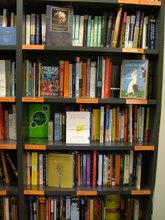The Nobel Prize in Physics 2007
Press Release
9 October 2007
The Royal Swedish Academy of Sciences has decided to award the Nobel Prize in Physics for 2007 jointly to
Albert FertUnité Mixte de Physique CNRS/THALES, Université Paris-Sud, Orsay, France,
and
Peter GrünbergForschungszentrum Jülich, Germany,"for the discovery of Giant Magnetoresistance".
Nanotechnology gives sensitive read-out heads for compact hard disks
This year's physics prize is awarded for the technology that is used to read data on hard disks. It is thanks to this technology that it has been possible to miniaturize hard disks so radically in recent years. Sensitive read-out heads are needed to be able to read data from the compact hard disks used in laptops and some music players, for instance.In 1988 the Frenchman Albert Fert and the German Peter Grünberg each independently discovered a totally new physical effect – Giant Magnetoresistance or GMR. Very weak magnetic changes give rise to major differences in electrical resistance in a GMR system. A system of this kind is the perfect tool for reading data from hard disks when information registered magnetically has to be converted to electric current. Soon researchers and engineers began work to enable use of the effect in read-out heads. In 1997 the first read-out head based on the GMR effect was launched and this soon became the standard technology. Even the most recent read-out techniques of today are further developments of GMR.A hard disk stores information, such as music, in the form of microscopically small areas magnetized in different directions. The information is retrieved by a read-out head that scans the disk and registers the magnetic changes. The smaller and more compact the hard disk, the smaller and weaker the individual magnetic areas. More sensitive read-out heads are therefore required if information has to be packed more densely on a hard disk. A read-out head based on the GMR effect can convert very small magnetic changes into differences in electrical resistance and there-fore into changes in the current emitted by the read-out head. The current is the signal from the read-out head and its different strengths represent ones and zeros.The GMR effect was discovered thanks to new techniques developed during the 1970s to produce very thin layers of different materials. If GMR is to work, structures consisting of layers that are only a few atoms thick have to be produced. For this reason GMR can also be considered one of the first real applications of the promising field of nanotechnology.
originated from: http://nobelprize.org/nobel_prizes/physics/laureates/2007/press.html
2007/10/12
2007/10/09
Quantum spin Hall effect uncovered in HgTe
Physicists in Germany and the US have seen the first hints of an unusual solid-state phenomenon known as the quantum spin Hall effect (QSHE), in which spin-polarized electrons at the edges of an insulator are able to conduct. The researchers have seen this edge conduction in thin sheets of mercury telluride although they were not actually able to confirm that these edge electrons were spin-polarized. QSHE is interesting because it could be useful for making spintronic devices that exploit both the spin and charge of the electron.
Physicists in Germany and the US have seen the first hints of an unusual solid-state phenomenon known as the quantum spin Hall effect (QSHE), in which spin-polarized electrons at the edges of an insulator are able to conduct. The researchers have seen this edge conduction in thin sheets of mercury telluride although they were not actually able to confirm that these edge electrons were spin-polarized. QSHE is interesting because it could be useful for making spintronic devices that exploit both the spin and charge of the electron.

Spins on the edge
All physicists are familiar with the classic Hall effect, in which electrons moving in a thin sample in the presence of a transverse magnetic field experience a force that pushes them towards one side of the sample. This creates a charge imbalance that leads to a voltage across the material. In 2004, however, physicists obtained the first evidence for the "spin Hall effect", in which "spin-up" and "spin-down" electrons are deflected to opposite sides of a semiconductor. The resulting spin separation creates a spin current that is prependicular to the direction of the electric current.
The quantum spin Hall effect (QSHE) is a related phenomenon that has been predicted to occur not in conductors, but in certain very thin insulators. It involves spin-up electrons conducting along one edge of the insulator, with spin-down electrons conducting along the other side. Despite being insulators in the bulk, conduction is allowed at the edges because the interaction between the spin and orbital angular momentum of the electrons reduces the energy gap between the valence and conduction bands to zero for spin-polarized electrons.
Last year Shou-Cheng Zhang and colleagues at Stanford University in the US predicted that very thin sheets of mercury telluride (HgTe) should have the right band structure to support edge conduction. Now Zhang has joined forces with Laurens Molenkamp and colleagues at the University of Wuerzburg in Germany to find the first experimental evidence of QSHE in HgTe "quantum wells" -- sheets of material a few nanometers thick in which the electrons are confined to two dimensions.
Electrodes were attached to the wells to measure their conductance when cooled to about 30 mK. The same non-zero conductance predicted by Zhang was seen in all wells ranging in thickness from 6.3 to 12 nm. Because the conductance did not increase with well thickness, the researchers concluded that the conduction was occurring along the edges of the well, rather than in the bulk of the material.
However, wells thinner than 6.3 nm behaved like insulators – in agreement with Zhang’s theory, which predicted that very thin wells would not have the appropriate band structure for the QSHE. When the team applied a magnetic field to the thicker wells, the edge conduction vanished – again in agreement with theory.
Despite their success at seeing edge conduction, the team was not able to confirm that the conducting electrons were spin polarized. "There is certainly more work to be done in this direction," says Charles Kane of the University of Pennsylvania, who has predicted that the QSHE should also occur in very thin sheets of carbon called graphene. "But I don't think that it detracts from the importance of this experiment”, he added.
Molenkamp told physicsworld.com that the team is now exploring how a SQUID magnetic probe could be integrated within the quantum wells to measure the spin polarization of the edge electrons. And because spin-polarized edge electrons are expected to encounter no electrical resistance, edge-conducting insulators could be used in very low-power spintronic devices that use both the spin and charge of the electron to store and process information.
The researchers presented their work in Science.
Originated: http://nanotechweb.org/cws/article/tech/31344
2007/10/05
50th Anniversary of the Space Age ~ 50 Years of Inspiration, Innovation and Discovery

1957: Sputnik satellite blasts into space
A Russian satellite has been launched into space - the first man-made object ever to leave the Earth's atmosphere. The Russian news agency, Tass, said the satellite Sputnik was now 560 miles (900 kilometres) above the Earth and circling it every hour-and-a-half. Scientists predict the metal sphere will eventually burn up in the atmosphere but they hope it will send important data back to Earth before doing so. The Soviet Union and the USA have both committed to launching satellites for research as part of the International Geophysical Year (IGY).
Delegations from both countries' IGY committees were at a reception at the Russian embassy in Washington when news of Sputnik's launch came through. The chairman of the American IGY committee, Dr Joseph Kaplan, congratulated the Russians on a "remarkable achievement".
The leader of the Russian delegation, Dr A A Blagonravov, who is believed to have been closely involved with the preparations for the launch, described Sputnik as "the simplest kind of baby moon". He attributed its weight - 180lb (83.5kg) - largely to heavy batteries.
'Nothing to fear' The satellite's weight has led some American experts to speculate that the rocket which launched it might also be capable of carrying a nuclear weapon thousands of miles.
The fact that Sputnik is expected to fly over the US seven times a day has also caused unease.
There have already been calls for an immediate review of US defences, given the implications of the technological leap ahead by a political enemy. But Dr Blagonravov said no-one had anything to fear from the Soviet satellite programme. "It will keep everyone too busy watching the instruments to think about anything else," he said. President Eisenhower has been informed of the Russian success. But he said the news would not lead the US to accelerate its own satellite programme. The first US launch is expected next month.
A Russian satellite has been launched into space - the first man-made object ever to leave the Earth's atmosphere. The Russian news agency, Tass, said the satellite Sputnik was now 560 miles (900 kilometres) above the Earth and circling it every hour-and-a-half. Scientists predict the metal sphere will eventually burn up in the atmosphere but they hope it will send important data back to Earth before doing so. The Soviet Union and the USA have both committed to launching satellites for research as part of the International Geophysical Year (IGY).
Delegations from both countries' IGY committees were at a reception at the Russian embassy in Washington when news of Sputnik's launch came through. The chairman of the American IGY committee, Dr Joseph Kaplan, congratulated the Russians on a "remarkable achievement".
The leader of the Russian delegation, Dr A A Blagonravov, who is believed to have been closely involved with the preparations for the launch, described Sputnik as "the simplest kind of baby moon". He attributed its weight - 180lb (83.5kg) - largely to heavy batteries.
'Nothing to fear' The satellite's weight has led some American experts to speculate that the rocket which launched it might also be capable of carrying a nuclear weapon thousands of miles.
The fact that Sputnik is expected to fly over the US seven times a day has also caused unease.
There have already been calls for an immediate review of US defences, given the implications of the technological leap ahead by a political enemy. But Dr Blagonravov said no-one had anything to fear from the Soviet satellite programme. "It will keep everyone too busy watching the instruments to think about anything else," he said. President Eisenhower has been informed of the Russian success. But he said the news would not lead the US to accelerate its own satellite programme. The first US launch is expected next month.
訂閱:
文章 (Atom)








